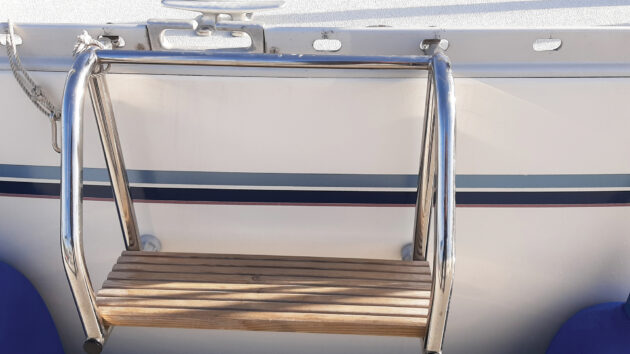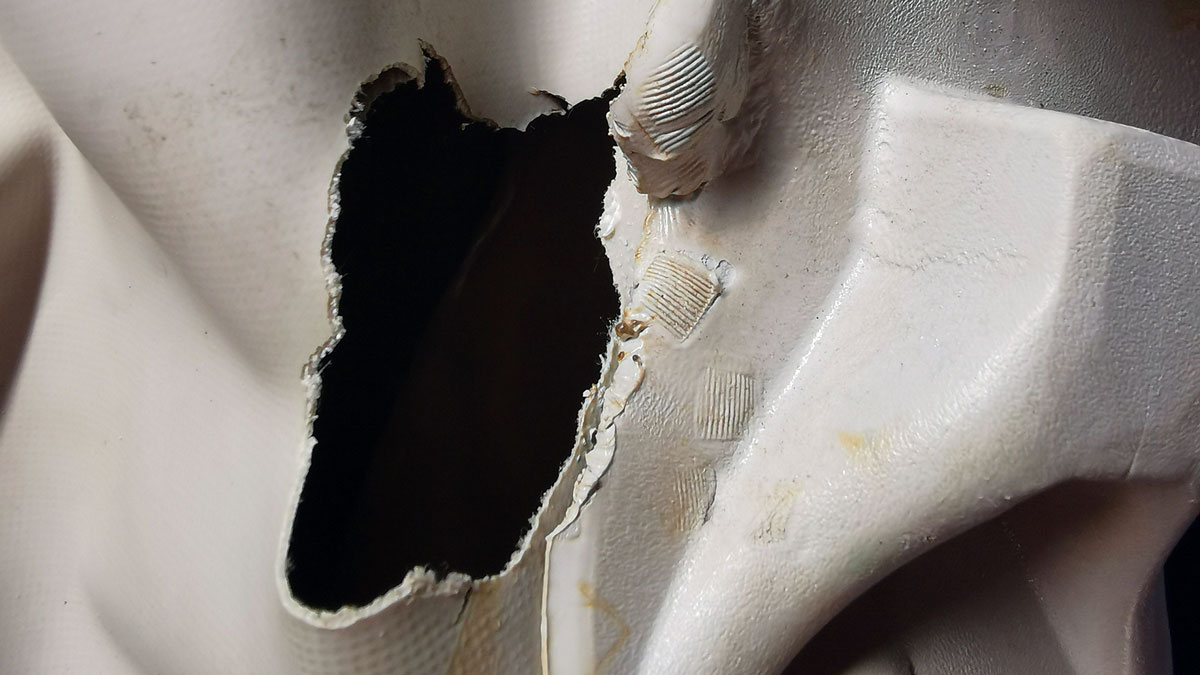A DIY project for the big day! For his wedding photos, Thomas Parker built a smart boarding step for getting safely on and off the pontoon.
I made a stainless steel boat boarding step for my Moody 346, Klondike Kate, primarily for my wedding so my wife, Heather, would not have to struggle aboard in an ungainly manner for our wedding photos – she’s much more at home in oilskins than a dress, writes Thomas Parker.
Since then, the step has been greatly admired, both in my home ground of Strangford Lough, Northern Ireland, and when we went cruising in Western Scotland.

The wooden step is supported by a stainless steel tubing strut.
The project
Coming alongside a pontoon can be tricky enough at the best of times and more so if entering a strange marina. With concentration firmly focused on boat speed, wind direction and other boats (plus the unwanted attention of other sailors) the skipper has to be confident that the crew will be able to jump from boat to pontoon quickly and tie up the mooring lines swiftly.
One small but often overlooked piece of equipment to help this is the boarding step.
This can be a fender step, or if you have a small freeboard, then no step at all.
The trouble with fender steps is they can be squashy, especially if not fully inflated, changing shape or wobbling when a person’s weight is on them.

Close-up of how the step is hooked on. Credit: Thomas Parker
Boat boarding step parts list
Here’s everything I needed to make the step:
- 25mm stainless steel tubing, for the frame
- 20mm stainless steel tubing for top and bottom cross pieces
- Length of wooden decking
- 4 x 35mm stainless steel screws
- 2 black stop ends
- 2 grey rubber stoppers from a walking mobility aid (black stoppers leave marks on the hull)
- Services of a stainless steel fabricator and welder

A lanyard helps prevent the step from being dropped overboard during deployment. Credit: Thomas Parker
The solution
Klondike Kate has aluminium toerails with scupper holes and my step neatly clips into these holes, making a rigid platform that falls halfway between the deck and pontoon.
It’s therefore very easy for Heather (or anyone else, for that matter) to step onto the pontoon safely and do her crew bit of tying up the forward and aft lines.

Angled brackets will hook into the boat’s toerail holes.
A removable boarding step is safer and more comfortable
If you have weak or dodgy knees, the step takes the ‘jarring potential’ out of landing on the pontoon.
A rope lanyard with a snap clip secures the step to the boat, just in case it’s dropped when attaching it to the toerail.
The dimensions to fit the toerail for my boat are 49cm wide, 38cm high, a step depth of 14.5cm and a total depth of 24cm – but these can be modified to fit other toerails on other boats.
The step is stored neatly in the cockpit locker when not in use.
Email your Practical Projects and tips to pbo@futurenet.com including high resolution photos where possible. We pay at least £30 for each one published.
DIY bunk ladder for getting in and out of berths easily
Don Fitzroy Smith fashions cheap, light, easy to stow and make bunk ladder and headboards for getting in and out…
DIY boat ladder: how to make one on a budget
Zoran Glozinic shares how he made a safe and sturdy DIY boat ladder on a minimal budget
Repairing an inflatable dinghy: fixing holes
Paul Diamond repairs a dinghy that was chewed by rodents
How to make your own rigging vice
Zoran Glozinic builds a specialised wire rigging tool
Want to read more articles like this?

A subscription to Practical Boat Owner magazine costs around 40% less than the cover price.
Print and digital editions are available through Magazines Direct – where you can also find the latest deals.
PBO is packed with information to help you get the most from boat ownership – whether sail or power.
-
-
-
- Take your DIY skills to the next level with trusted advice on boat maintenance and repairs
- Impartial, in-depth gear reviews
- Practical cruising tips for making the most of your time afloat
-
-
Follow us on Facebook, Instagram, TikTok and Twitter








